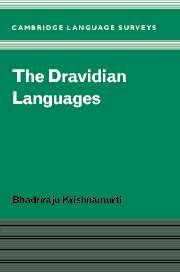Book contents
- Frontmatter
- Contents
- List of illustrations
- List of tables
- Preface
- Acknowledgements
- Note on transliteration and symbols
- List of abbreviations
- 1 Introduction
- 2 Phonology: descriptive
- 3 The writing systems of the major literary languages
- 4 Phonology: historical and comparative
- 5 Word formation: roots, stems, formatives, derivational suffixes and nominal compounds
- 6 Nominals: nouns, pronouns, numerals and time and place adverbs
- 7 The verb
- 8 Adjectives, adverbs and clitics
- 9 Syntax
- 10 Lexicon
- 11 Conclusion: a summary and overview
- Bibliography
- Index of reconstructions with glosses
- General index
8 - Adjectives, adverbs and clitics
Published online by Cambridge University Press: 22 September 2009
- Frontmatter
- Contents
- List of illustrations
- List of tables
- Preface
- Acknowledgements
- Note on transliteration and symbols
- List of abbreviations
- 1 Introduction
- 2 Phonology: descriptive
- 3 The writing systems of the major literary languages
- 4 Phonology: historical and comparative
- 5 Word formation: roots, stems, formatives, derivational suffixes and nominal compounds
- 6 Nominals: nouns, pronouns, numerals and time and place adverbs
- 7 The verb
- 8 Adjectives, adverbs and clitics
- 9 Syntax
- 10 Lexicon
- 11 Conclusion: a summary and overview
- Bibliography
- Index of reconstructions with glosses
- General index
Summary
Introduction
In this chapter I treat certain parts of speech which are identified mainly syntactically, namely adjectives, adverbs and clitics. There are a few words which are basic adjectives and adverbs, e.g. in adjectives the three deictic bases ā ‘that’, ī ‘this’ and ē ‘what?’ occur only in attributive position before noun heads. There are also certain suffixes, which derive adjectives from nominals (nouns, pronouns, numerals etc.) and verbs (the relative participles), but all adjectives are identified as a class only by their syntactic function as qualifiers of noun heads. The exclusive basic adverbs that I can think of are reduplicated expressions, which function as manner adverbials, e.g. Te. gaṇṭa gaṇagaṇa mōgindi ‘the bell rang gaṇa gaṇa’, wāḍu gaḍagaḍa māṭlāḍatāḍu ‘he speaks fast’. Clitics are indeclinable. They are syntactic affixes, which can be added to any autonomous unit, i.e. word, phrase, clause, with various shades of meaning, e.g. *ā, added to declarative sentences to convert them into ‘yes–no’ questions, *ē (also *tān ‘self’ in Tamil), an emphatic particle meaning ‘only’, and *ō to express doubt or ‘either–or’ relationship, etc. Each language has created a host of such clitics, beside the inherited ones. These three parts of speech will be treated comparatively below.
Adjectives
Adjectives, like the other major parts of speech, nouns and verbs, can be defined in terms of certain universal semantic types and certain language-specific morpho-syntactic properties.
- Type
- Chapter
- Information
- The Dravidian Languages , pp. 388 - 419Publisher: Cambridge University PressPrint publication year: 2003



